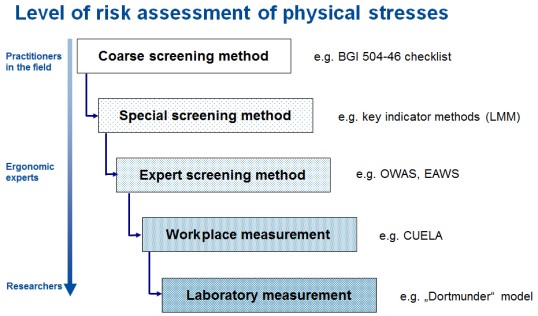- Artificial Intelligence (AI)
- Occupational exposure limit values
- List of CMR substances
- Ergonomics
- EU GHS Regulation
- Industrial Security
- Collaborative robots
- Noise
- Nanoparticles at the workplace
- NoRA OSH standards search tool
- REACH
- Reference materials
- Proficiency testing
- Radiation
- Vibration
- Virtual reality
- Work 4.0
MEGAPHYS: multilevel risk assessment of physical exposures
Risk assessments of physical stresses
The German Federal Institute for Occupational Safety and Health (BAuA) and the DGUV have agreed to join forces in further developing the risk assessments for physical stresses. The objective of the joint research project is to develop a comprehensive inventory of methods for the performance of in-company risk assessments for physical stresses caused by the manual handling of loads, repetitive work processes, tasks involving the exertion of high effort, constrained postures, tasks involving intensive movement, and combined stresses associated with mixed tasks. In particular, the research project is to develop scientifically validated assessment metrics and to produce a co-ordinated inventory of methods with multiple levels of differentiation of the risk assessment (special screening, expert screening, analytical instruments). For this purpose, experts will co-operate from the areas of ergonomics, occupational medicine, biomechanics, ergonomics and occupational physiology.
The joint endeavour is divided into seven work packages. The studies are to be based upon a detailed literature survey of existing analysis, assessment and evaluation methods (work package 1) and a status analysis of the incidence of physical stresses in the world of work (work package 2). Based upon the results, provisional assessment models are to be formulated (work package 3) for a number of risk factors (such as lifting, carrying, pulling and pushing of loads, repetition, exertion of force), target organs (such as the back, upper and lower extremities), target groups (such as employers, OSH professionals, researchers) and degrees of complexity (such as simple screening, analytical instruments). Following trialling of the provisional methods in companies by a number of user groups (such as OSH professionals, supervisors; work package 4), they are to be improved and applied in approximately 50 companies for the purpose of iterative evaluation (work package 5). The intended result of this work package is a complete inventory of methods for all evaluation levels, individual factors of which can be revised as necessary and re-evaluated with reference to the results of further practical application of the screening methods and to measurements performed in parallel (work package 6). Finally, the results are to be compiled, documented and interpreted (work package 7).
With the exception of work package 2, the IFA is substantially involved in all work packages and, together with the BAuA, will assume the task of organizing the project and co-ordinating the research partners. The focus of the IFA's method development activity will particularly lie within the area of analytical instruments: approximately 120 measurements in companies are planned, which will include measurements of body postures and movements (CUELA system), muscle activity (electromyography, EMG) and force exertion (force grips), together with the development of standardized measurement records for the measurement parameters studied.
Completion of the research project is anticipated for 2018.
Project partners:

- The Institute for Occupational Safety and Health of the German Social Accident Insurance (IFA), Sankt Augustin
- Federal Institute for Occupational Safety and Health (BAuA), Berlin
- Institute of Occupational Health, Safety and Ergonomics Association (ASER), Wuppertal
- Institute of Ergonomics of Darmstadt University of Technology (IAD)
- Leibniz Research Centre for Working Environment and Human Factors at TU Dortmund University (IfADo)
- ARBMEDERGO, Hamburg
Contact:
Administrative Unit Innovative Work Design
Tel: +49 30 13001-3030Fax: +49 30 13001-3030

